Enchantment in Jewish Pilgrimage
Read about our work on British Jews and their relations to Jerusalem.
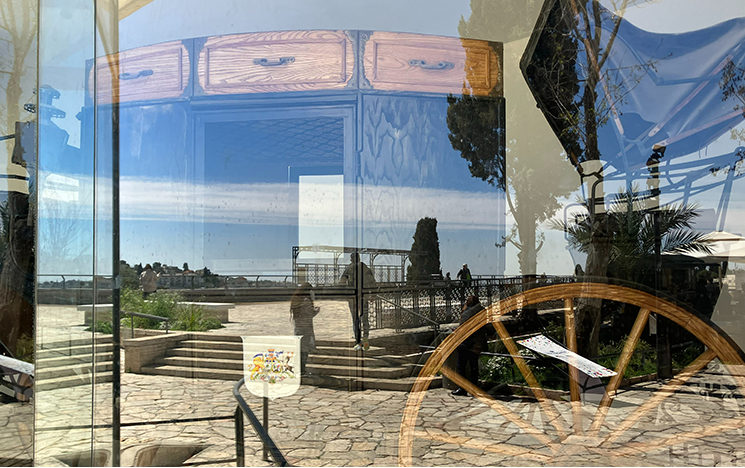
Image of Jerusalem Moses Montefiore Windmill and Carriage
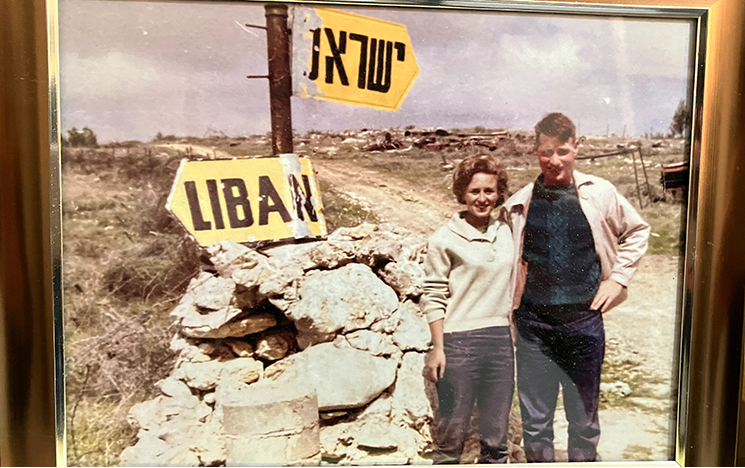
Members of Birmingham Jewish community, Anthony Joseph, and his late first wife, Jane, during Israel trip. 1964
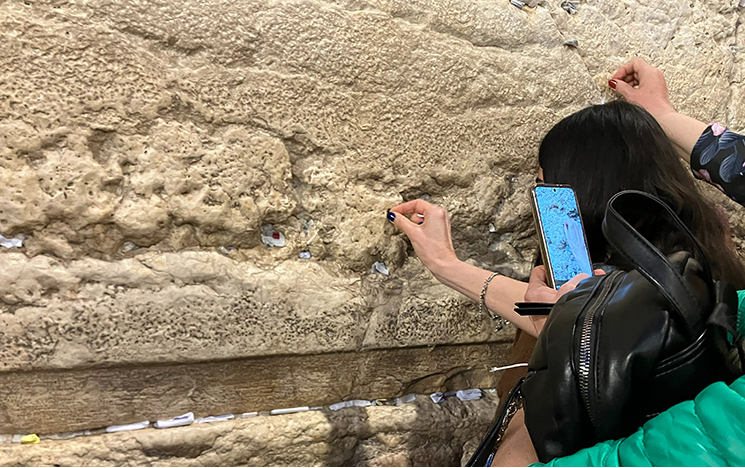
People leaving notes to God at Western Wall, Jerusalem
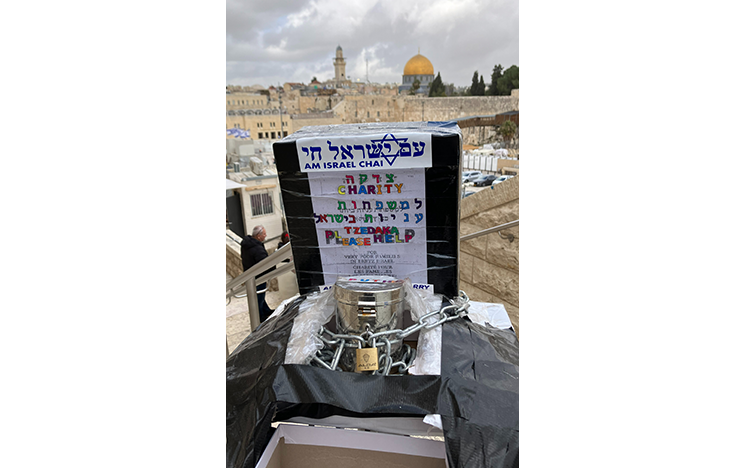
Image of Jewish Tzedakah box
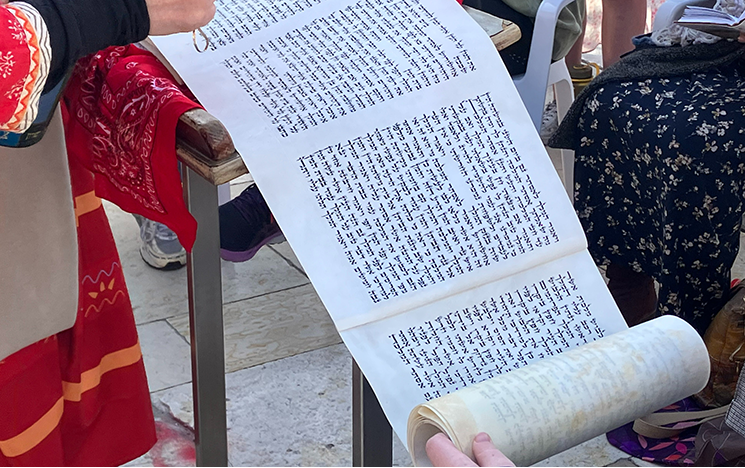
Jerusalem, Shushan Purim, Women of the Wall group reading from Megillat Esther, against orthodox tradition
This workstream concentrates on British Jews and their relations to Jerusalem, a contested city that hosts sacred sites for all three major monotheistic religions.
The Three Pilgrimage Festivals (Shalosh Regalim) mentioned in the Hebrew Bible are associated with Jerusalem. This religiously-prescribed travel and dwelling has contributed to the city’s economic growth. Indeed, rabbinic texts stipulate that pilgrims should spend money earned from the second tithe when visiting the Holy City.
Since the foundation of Israel in 1948 and especially after the Six-Day War, Israel’s Jewish sacred geography has changed dramatically. While Jerusalem continues to be the most visited Jewish sacred site in Israel, other pilgrim destinations - among them sites of venerated biblical figures as well as tombs of Talmudic sages, rabbis and kabbalist, often located in Israel’s peripheral and economically deprived areas - are also attracting visitors and commercial enterprise.
Based among the diverse Jewish communities living in Birmingham and the West Midlands, WS4 considers questions of religiosity and entrepreneurship as it applies to diasporic Jews in pilgrimages/tours to sites of historical and religious significance to Jews. It illuminates on how pilgrimonics affect the sense and politics of place in Britain as well as Israel’s evolving sacred Jewish geography in and beyond Jerusalem with expanding commercialisation, and what role Jewish conduct and concepts such as tzedakah (righteousness) as an ethical obligation play in charitable giving.
Workstream Lead Gabriele Shenar
Workstream Blog
Mitzvah Day 2023: a short film by Gabriele Shenar and Tarun Jasani
- Video transcript
Prepared by Gabriele Shenar
Jewish tune playing. Title appears in white text against a black background:
“Mitzvah Day: A Jewish-led multi-faith day of social action.”Wide shot: interior of entrance hall, Alexandra Hospital, Redditch. Members of the Mitzvah Day team in green T-shirts stand behind the cake stall for a photo opportunity.
Close-up of cakes and biscuits on the table.
Over-the-shoulder shot: NHS staff approach the cake stall. A Mitzvah Day team member calls out, “Mitzvah Day!” Various shots of NHS staff in front of the cake stall.
Close-up of a large sign:
“Worcester Interfaith Forum”
“United in Friendship”
Symbols of various religions. Heat map in background.Various shots of the cake stall and Mitzvah Day team distributing leftovers to NHS staff.
Close-up of a hand holding a plate, and another hand taking a slice of cake.
Close-up of a woman preparing hot drinks. A person is wearing a green “Mitzvah Day” T-shirt.
Shot of an empty table and a plate with leftovers.
People taking pictures with mobile phones.
Group photo of the Mitzvah Day team and green bunting.
Credits:
Filmed by Gabriele Shenar
Edited by Tarun JasaniLogos:
Pilgrimonics
The Leverhulme Trust
University of Sussex.
Sukkot between Jerusalem and Birmingham: a short film by Gabriele Shenar and Tarun Jasani
- Video transcript
Prepared by Gabriele Shenar
Filmed in Birmingham, October 2022, and Jerusalem in autumn 2023.
Title appears in white text against a black background:
“Sukkot between Jerusalem and Birmingham”
(Lively music playing)Wide shot of Mahane Yehuda Market, Jerusalem.
A woman in a purple hat wishes shoppers a happy new year in Hebrew and a good final sealing for Yom Kippur, the Jewish Day of Atonement.
Caption (translation from Hebrew to English): Shana Tova, may you be inscribed for a good year.A woman holds out her hand to receive coins from a shopper who is leaving the market.
Long shot of the tent housing the Sukkot market.
A sign in Hebrew reads "Exit" as people walk into the tent.
Over-the-shoulder shot of a group of Orthodox Jewish men in traditional black garb at an etrog stall.
(Jewish tune playing)
Another over-the-shoulder shot of Orthodox Jewish men inspecting the quality of merchandise laid out on a stall.
White handwritten signs display price information in Hebrew.Various shots of Orthodox Jewish men checking twigs of myrtle (hadass) for blemishes.
A group of Orthodox Jewish men inspect an etrog (citron) and palm twig with a microscope for blemishes.
Hands are seen making lulav holders from palm leaves.
Various shots of male stallholders and customers at the stalls.
Close-up of ceiling decorations. Wide shot of the Sukkot market and its decorations. Close-up of a white dove decoration.
Wide shot of Jaffa Street, Jerusalem. People walk along the street. Various commercial sukkot are visible. A light rail train approaches, and its bell chimes.
(Jewish tune playing)
Wide shot of the Old City wall near Jaffa Gate, Jerusalem. Israeli policemen are mounted on horses. Orthodox Jews walk nearby.Wide shot of Mamilla Street and the Jaffa Street crossing. Jerusalem town hall, Israeli policemen on horseback, and the light rail are shown.
(Jewish tune playing)
On Jaffa Street, Jews watch others holding large lulav and etrog sets.(Popular Mizrachi tune playing)
In Jerusalem, opposite the town hall near the Old City wall, an Israeli flag is visible. Jewish pilgrims are present in the Mamilla neighborhood.
An anti-modern media-technologies campaign is shown: two Orthodox Jewish men (possibly Mizrachi) hold placards, dance, and distribute leaflets.
Caption: Life is happy even without internet, movies, and kosher phones.Near Jaffa Gate, a Klezmer band plays. Jewish visitors listen. The scene includes Mamilla Quarter and Street. A pan to the left reveals the Old City wall and Jaffa Gate.
(Klezmer band playing in background)
A large crowd walks toward Jaffa Gate during the Sukkot holiday in the Old City of Jerusalem.A left pan shows the Old City wall, stalls, and Hasidic Jews at a stall. A voice wishes a happy holiday in Hebrew.
Inside the Old City of Jerusalem, in the Jewish Quarter near the Dung Gate entrance. Partial view of the Al Aqsa Mosque.
Signs in Hebrew read “Aroma” and “Davidson Centre.” The Jerusalem Archaeological Park and the new museum are visible.A group of Jewish men in prayer shawls, carrying sets of lulav and etrog, stand inside a sukkah.
(Jewish tune playing)
Inside the tunnel leading to the Western Wall Plaza. Turnstiles of a security checkpoint are seen in the background. A right pan reveals the tunnel exit.(Jewish tune continues)
Exiting the tunnel, a wide shot reveals the Western Wall Plaza area with people. A pan to the right shows the information desk, a welcome sign to the Western Wall Plaza, and signage explaining permitted and prohibited activities.Wide shot of the entrance to the Western Wall tunnels. A sign reads “Chag Sameach” for the Sukkot festival. A welcome sign is visible.
A pan to the right reveals the Western Wall and Mughrabi Gate. A gender partition is seen separating the men’s and women’s sections. Signs in Hebrew read “Men” and “Women.” A worker paints markings on the floor.Wide shot of a large sukkah in the Western Wall Plaza area.
A sign in English and Hebrew reads:
“This Sukkah is for prayer, learning, and blessing on the four species only.”
The camera pans inside the sukkah, tilting to the ceiling with decorations, then tilts down.
Night views: Birmingham
Progressive Synagogue, evening of the first night of Sukkot 2022.
Rabbi Margaret Jacobs stands with the congregation inside the sukkah.She chants the traditional Hebrew prayer for dwelling in the sukkah, then repeats it in English:
“Thank you, God, for giving us the opportunity to dwell in the sukkah.”Rabbi Jacobs and the congregation chant the Shehecheyanu, a Jewish prayer recited to celebrate special occasions.
Rabbi Jacobs supervises the shaking of the lulav and etrog, an essential ritual during Sukkot.
(Jewish tune playing)
Credits:
White text against black background:
Filmed by Gabriele Shenar
Edited by Tarun JasaniLogos:
Pilgrimonics
The Leverhulme Trust
University of Sussex.
Urban Transcendence - Jerusalem and Tel Aviv: a short film by Gabriele Shenar and Tarun Jasani
- Video transcript
Prepared by Gabriele Shenar
Filmed in 2023 in Jerusalem and Tel Aviv, Israel.
Jerusalem – Night Views, Autumn 2023
Title: Urban Transcendence: Jerusalem & Tel Aviv
(Title fades out)Night views of Jerusalem: First Station area and Old City.
Sound of traffic. A bus moves along David Remez Road, near the First Station (Old Train Station), Jerusalem. A road sign points to the Old City, Talpiyot, and Abu Tur.
The traditional song “Jerusalem of Gold” plays.
Zion Hotel, Hebron Road. Wide shot of the Old City of Jerusalem and Eliyahu Hanavi Street leading up to Mount Zion. Illuminated residential areas are visible.On Eliyahu Hanavi Road, a bus drives past. The view opens toward the Valley of Hinnom (Gehenna), with illuminated residential areas in the valley.
A sign reads: Western Wall, Music Centre.
Ma’ale HaShalom Road leads to Dung Gate, Old City. A Jewish visitor and Israeli policemen walk through Dung Gate into the Western Wall Plaza area.
The traditional song “Jerusalem of Gold” continues. Jewish visitors walk towards the Western Wall.
At the Western Wall Plaza, visitors enter the women’s prayer area. A banner in Hebrew reads: red “No Entry”, green “Entry.”
Wide shot of people walking into the Western Wall prayer area.
Sound of people singing Jewish tunes. A group of national religious male youth sing and move slowly in a circle. The camera tilts to the surrounding buildings, then pans back to the prayer area.Wide shot of the Western Wall prayer area. A large crowd has assembled for a special prayer event: Selichot.
Tel Aviv – Daytime, Rosh Hashanah, September 2023
A modern tune plays.
At Park Ha’Mesilah (old train tracks), graffiti covers walls and buildings.Wide shot of the Mediterranean Sea. Near the Old Train Station area, the camera pans right to the beach promenade. Various secular and religious Jews and tourists walk along the beach. Birds pick at bread. The camera pans to the sea.
Tel Aviv – Frishman Beach and Dan Hotel Area
In red sunlight by the sea, a Jewish man wearing a kippa blows the shofar (ram’s horn) for Rosh Hashanah. Jewish people watch.
Another man blows the shofar among people walking along the promenade.
A Jewish man in shorts blows the shofar while standing in the sea.
A Hasidic Jew blows the shofar while standing on stairs leading to the beach area.
The camera pans from the sea to nearby buildings and traffic.
A group of Breslover Hasidim, dressed in white garments, talk to passersby, sing while walking along the pavement, and distribute sweets for Rosh Hashanah.
Among them, one young Jewish man wears a machine gun.Pan to the right: sea, sun, and people on the beach.
A man reads from a Jewish prayer book. The camera pans to the sea, the sun, and people on the promenade.
Jerusalem – Western Wall Plaza, Night Views
Sound of Jewish prayer and song.
Ritual washing of hands before prayer: water running, hands visible, various Judaica hand-wash cups.Close-up of Jewish prayer books.
In the women’s area of the Western Wall, a large donation container stands nearby. Women insert coins into the slot.
Various close-ups of women with prayer books.
Camera pans to the male prayer area, then back.An Israeli woman, possibly event security personnel, speaks into a loudspeaker, telling the crowd in Hebrew to make space for others who are still arriving.
Sound of the prayer leader.
Various scenes from the Selichot (penitential) prayers during the Central Selichot services at the Western Wall, viewed from the women’s area.
Close-ups of prayer books and praying women.More views of the Selichot prayer service from the Western Wall Plaza. Partial view of the Mughrabi Gate, the only access point for Jews and non-Muslim tourists to the Temple Mount.
Jews are praying and bowing.
A young Jewish man wears a T-shirt that reads: “Give me Space.”
Tel Aviv – Frishman Beach, Night View, Rosh Hashanah 2023
Sunset over the beach.
A group of Jews—some from Tel Aviv International Synagogue—pray and chant “Amen.”
Close-up of a mobile phone filming the event, and an open prayer book.Sound of the shofar.
Wide shot of the sea and beach as the group listens to the prescribed ram’s horn blasts.
The group applauds and cheers.They sing the traditional Jewish song “Oseh Shalom.”
Jews toss pieces of bread into the sea—a Jewish custom symbolizing the casting away of one’s sins (Tashlich).
A Jewish woman from Tel Aviv performs Selichot.
Sound of singing in the background.A group of Jews stands with a rabbi, singing “Oseh Shalom” while standing on the sand near the beach.
Some clap, and the rabbi makes dance-like movements.
Camera pans right to the promenade and nearby hotels.The group sings the Israeli national anthem. Applause. Some people embrace.
Jerusalem – Western Wall Plaza, Night View
Various scenes of Jews leaving the Selichot prayer service.
Wide shot of the exit. A sign in Hebrew reads: “Exit.”
Over-the-shoulder shot of people walking toward Dung Gate.People walk to the bus stop on Ma’ale HaShalom Road, near Dung Gate.
Two boys prepare bread.
Sign for bus number 1 appears in Arabic.
People board the bus.
The bus drives downhill on Ma’ale HaShalom Road toward Eliyahu Hanavi Road.
An Orthodox Jew in traditional black garb walks uphill.
Sound of cars in the background.
Tel Aviv – Evening, Twilight
Wide shot of Frishman Beach area.
The sea, sun, people, and beach are visible.
Sound of the sea.
Sunset on the horizon.Two Breslover Hasidic Jews in white garments pose for a photo opportunity, dancing on the beach.
A photographer stands in the water, filming.Various members of the Israeli press film the dancing and singing of the Breslover Hasidic Jews at the beach.
Credits:
Filmed by Gabriele Shenar
Edited by Tarun JasaniLogos:
Pilgrimonics
The Leverhulme Trust
University of Sussex